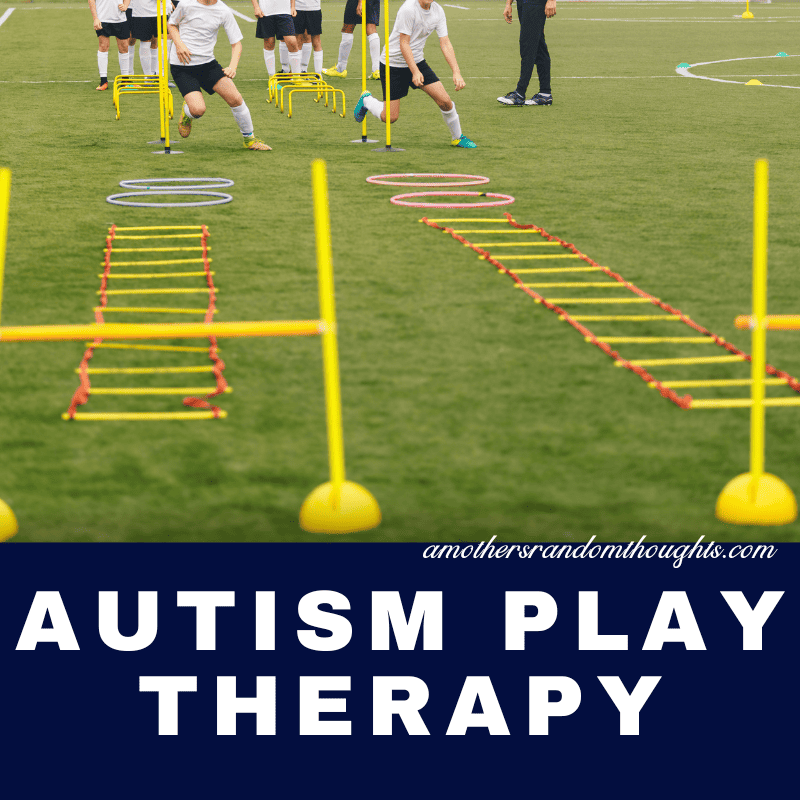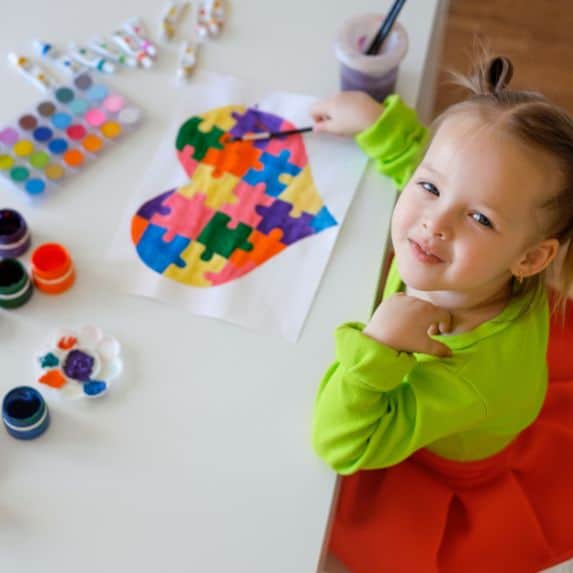Plus, Other Ways to Make Therapy Fun for Autistic Kids
Navigating life as the parent of a child with autism spectrum disorder can be challenging at times. Often, therapy sessions can seem daunting and monotonous to your child’s young mind. But what if we could turn traditional therapy into autism play therapy and make it an exciting adventure?
Explore several innovative and engaging ways to make therapy fun for children with autism. We believe that every child deserves a chance to learn and grow in a way that is enjoyable and meaningful for them. Let’s dive into the creative approaches that can transform your child’s therapy experience.
Remember that all types of autism play therapy can be done at home in a safe environment, and you can learn how to facilitate therapy and turn it into a play session. Occupational therapists can be used, but you can also consult a therapist to help you incorporate play therapy into your daily life.

Incorporating Play in Autism Therapy
Play is a universal language for children, and incorporating it into autism therapy sessions with a play therapist or at home with family members can unlock significant opportunities for progress. It’s not all about having fun; play activities can help children with autism develop critical social and communication skills.
Play intervention strategies can address common issues such as communication deficits and difficulty understanding social cues. Play can also create opportunities for the natural reinforcement of life skills, making the learning process more effective and engaging. Therapists can transform challenging tasks into enjoyable activities by using toys and games that interest the child, fostering a positive attitude toward therapy.

Pretend Play
Often times autistic children do not engage in pretend play like their non-autistic peers do. Often children on the spectrum lack social interaction skills and prefer to play alone. Therefore, it becomes essential to help your child develop new skills.
You can begin to teach pretend play by getting down on their level. Young children spend much time playing on the floor or ground outside. Floor time may require you to get down on the floor and play with them. Find different ways to incorporate “therapy” into their free play without them knowing it. Dolls, puppets, trucks, action figures, cars, blocks, and other manipulatives are great for helping you pretend play with your child.
Try to make natural eye contact while playing. It isn’t as scary to them when they are having fun.
Role play is another important aspect of pretend play. Playing “grocery store” or “doctor” can help children with their language skills and express feelings regarding the doctor’s office. Play therapy has so many benefits that it just makes sense to try imaginative play with your child. If your child is a firefighter, you can have them spray the water hose at “the fire,” or if they are a postman, they can deliver the mail. These are all fine ideas to engage your child.

Find What Your Child Loves
Therapy doesn’t have to look like work or drudgery. In fact, the type of therapy you choose should be fun for your special needs child. Some different types of play therapeutic activities include art therapy, music therapy, dance therapy, and horse riding therapy. However, our family looked at our child’s needs along with what sparked our child’s interests and devote a lot of time and money into “Disney therapy.”
We purchased books, movies, visited the movie theater often, and took many trips to Disney. Each one of those trips proved to be more beneficial than the speech-language pathologist or other early intervention therapy that was suggested. We saw an increase in positive behaviors and a child who wanted to connect with Disney characters.
Find what your child loves, and you may connect with him/her in new ways.
Sensory Bins
What is a sensory bin? Sensory bins are 1) easy to put together, 2) give your child the ability to explore with multiple senses, including sight, sound, touch, and smell (and maybe even taste), and 3) can easily be incorporated into your children’s play.
A sensory bin is a tool that your child believes is just playing. Furthermore, sensory bins can help with fine motor skills. To assemble a sensory bin, you need a plastic container (or a box) and loads of filler with objects scattered throughout. Choose your filler: glass beads, plastic pellets, kinetic sand, colored rice, water beads, beans, cotton balls, shredded paper, beans, colored pasta, aquarium rocks, dirt (this could get really messy), water, oat, corn or rice, or buttons.
Then you add in objects. Pick a theme or something your child likes and collect objects around that theme. If your child likes dinosaurs, add little plastic dollar-store dinosaurs. Just be careful that you either 1) watch your child to make sure they don’t put any small objects in their mouth or 2) avoid small objects.
Most people will tell you that sensory bins are for toddlers, but I enjoy playing with them too and I am an adult – I think!
Other Tips with sensory bins:
Buying new toys to add to the sensory bin occasionally is a fun way to keep sensory bins engaging.
Try a sensory bottle if you don’t have the space or time for a complete sensory bin. While it doesn’t have as many components, you can take it with you!
Starting with a theme helps you build sensory bins. If your child likes animals, build one with farm animals and add some farm toys such as mini tractors or a backhoe.

Engage Your Child With Art Therapy
Art therapy can be a potent tool that yields many benefits for children with autism. Creative activities like drawing, painting, or sculpting allow children the opportunity to express their emotions and thoughts in a non-verbal manner. It encourages them to explore their creativity and imagination, which can contribute to their cognitive development. Moreover, art therapy can help improve motor skills, increase focus, and reduce anxiety. This is a great way to make therapy fun for children with autism while also promoting their self-expression and improving their overall well-being.
Consider the Role of Music in Autism Therapy
Music therapy offers a unique and exciting approach to autism therapy. The rhythm and patterns inherent in music can help children with autism improve their motor coordination, communication, and social skills. Participating in musical activities such as singing, playing an instrument, or simply listening to music can have calming effects and stimulate emotional expression. Moreover, music can serve as a powerful motivator, making therapy sessions more engaging and enjoyable. The beauty of music therapy lies in its versatility—it can be tailored to suit each child’s preferences and therapeutic needs.
Furthermore, dance is a wonderful way for your child to express themselves. If they like dance, you can incorporate dance and new games such as The Hokey Pokey or even just free play to get the wiggles out.
Is Fun a Therapy?
When you engage your child in play, and they are having fun, it may be considered play therapy sessions to you, but it just is fun for them. Engage them with simple games or activities.
Hula hoops have many uses and can be fun for children and adults. If your child can’t use a hula hoop or gets frustrated, this is a perfect way to work on emotional skills. When your child fails and keeps trying, it can get frustrating, but learning that it is okay to get frustrated or fail at home is so much better than failing in front of other people where it doesn’t feel quite so safe.
Other Fun Play Experiences:
Obstacle Courses:
An obstacle course can help when a child struggles with physical play. Navigating themselves around different items to help with a variety of skills can help with physical challenges, enhance problem-solving skills, increase muscle strength and body awareness, help with balance and coordination, and can be a playful way to get children moving.

Playgroups:
It is understandable if you are reluctant to try a play group because your child doesn’t “play with others.” But even if your child only engages in parallel play (children play adjacent to one another without playing together), your child will see what other children are doing and may choose to join in at some point.
Experimenting in the Kitchen:
Make your own slime or other creations in the kitchen. Additionally, allow your children to play with their food. For me, this is relaxing and calming in a restaurant environment. I still make faces out of my leftover food, and while waiting for the waitress to return with the bill, it can be a great source of distraction. Make it a fun competition. Who knows, it may even encourage your child to try some new foods.
Build Social Skills Through Fun Activities
Engaging children in fun activities is a highly effective way to nurture their social skills. Whether it be sports, board games, or group art projects, these play experiences encourage interaction, cooperation, and teamwork. Board games can help a child learn to take turns, be patient, and strategize, while group art projects allow for the expression of individual creativity while contributing to a collective outcome. Moreover, these activities can also provide opportunities to practice social etiquette, explore non-verbal cues, and develop empathy by considering others’ perspectives and feelings.
Remember: Children learn best through play!


Reviewing movies for parents from a Christian perspective since 2005. Know Before You Go!
Christian Homeschooling mom – 30 years and counting
Autism Mom & Disney enthusiast
